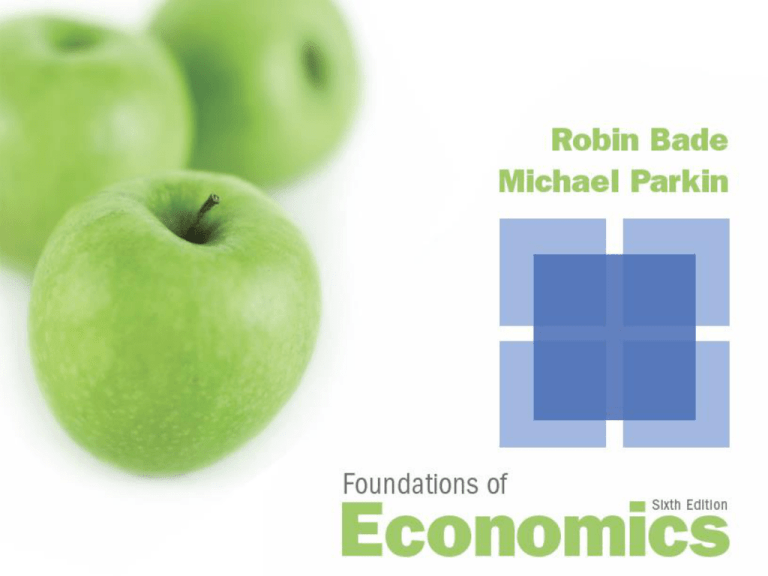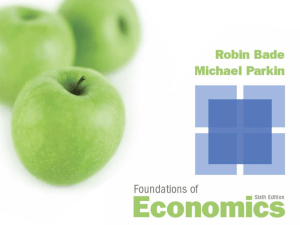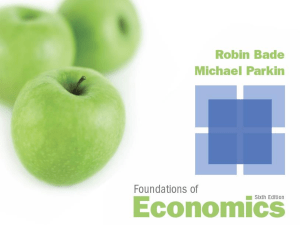Ch19
advertisement

Click on the button to go to the problem © 2013 Pearson Markets for Factors of Production 19 CHECKPOINTS © 2013 Pearson Click on the button to go to the problem Checkpoint 19.1 Checkpoint 19.2 Checkpoint 19.3 Problem 1 Problem 1 Clicker version Problem 1 Problem 2 Problem 2 Clicker version Problem 2 Problem 3 Problem 3 Clicker version Problem 4 Problem 4 In the news In the news © 2013 Pearson Clicker version In the news 1 In the news 2 CHECKPOINT 19.1 Practice Problem 1 Kaiser’s Ice Cream Parlour hires workers to produce smoothies. The market for smoothies is perfectly competitive, and the price is $4.00 a smoothie. The labor market is competitive, and the wage rate is $40 a day. What is the marginal product and the value of the marginal product of the fourth worker? © 2013 Pearson The table shows the workers’ total product schedule. CHECKPOINT 19.1 Solution The MP of hiring the fourth worker equals the TP of 4 workers (43 smoothies) minus the TP of 3 workers (33 smoothies), which is 10 smoothies. The VMP if the fourth worker equals the MP of the fourth worker (10 smoothies) multiplied by the price of a smoothie ($4), which is $40. © 2013 Pearson The table shows the workers’ total product schedule. CHECKPOINT 19.1 Practice Problem 2 Kaiser’s Ice Cream Parlour hires workers to produce smoothies. The market for smoothies is perfectly competitive, and the price is $4.00 a smoothie. The labor market is competitive, and the wage rate is $40 a day. How many workers will Kaiser’s hire to maximize its profit and how many smoothies a day will Kaiser’s produce? © 2013 Pearson The table shows the workers’ total product schedule. CHECKPOINT 19.1 Solution Kaiser’s maximizes profit by hiring the number of workers that makes VMP equal to the wage rate ($40 a day). The VMP if the fourth worker equals the MP of the fourth worker (10 smoothies) multiplied by the price of a smoothie ($4), which is $40. Kaiser’s hires 4 workers, and they produce 43 smoothies. © 2013 Pearson The table shows the workers’ total product schedule. CHECKPOINT 19.1 Practice Problem 3 Kaiser’s Ice Cream Parlour hires workers to produce smoothies. The market for smoothies is perfectly competitive, and the price is $4.00 a smoothie. The labor market is competitive, and the wage rate is $40 a day. If the price rises to $5 a smoothie, how many workers will Kaiser’s hire? © 2013 Pearson The table shows the workers’ total product schedule. CHECKPOINT 19.1 Solution Kaiser’s maximizes its profit by hiring 5 workers. When Kaiser’s hires 5 workers a day, the MP of the 5th worker is 8 smoothies. The price of a smoothie is $5, so VMP is $40 a day equal to the wage rate. © 2013 Pearson The table shows the workers’ total product schedule. CHECKPOINT 19.1 Practice Problem 4 Kaiser’s Ice Cream Parlour hires workers to produce smoothies. The market for smoothies is perfectly competitive, and the price is $4.00 a smoothie. The labor market is competitive, and the wage rate is $40 a day. Kaiser’s installs a new machine that increases the productivity of workers by 50 percent. © 2013 Pearson The table shows the workers’ total product schedule. CHECKPOINT 19.1 Kaiser’s installs a new machine that increases the productivity of workers by 50 percent. If the price remains at $4 a smoothie and the wage rises to $48 a day, how many workers does Kaiser’s hire? © 2013 Pearson The table shows the workers’ total product schedule. CHECKPOINT 19.1 Solution Kaiser’s maximizes its profit by hiring 5 workers. When Kaiser’s hires 5 workers, the MP of the 5th worker is 12 smoothies. The price of a smoothie is $4, so VMP is $48 a day, equal to the wage rate. © 2013 Pearson The table shows the workers’ total product schedule. CHECKPOINT 19.1 In the news Where have America’s jobs gone? U.S. companies offer many reasons for their lack of robust hiring, including weak consumer spending. Over the past year, there has been an increase in manufacturing, transportation, and health-care jobs, but not in sectors related to homes and housing. Source: The Wall Street Journal, July 12, 2011 Use the competitive goods and labor markets to explain why jobs in some sectors have grown but not in others. © 2013 Pearson CHECKPOINT 19.1 Solution A profit-maximizing firm hires the quantity of labor at which the VMP of labor equals the market wage rate. VMP of labor equals MP multiplied by the price of the good. If the price of the good or MP increases, firms offer more jobs. If the price of the good or MP is unchanged, firm don’t offer more jobs. © 2013 Pearson CHECKPOINT 19.2 Practice Problem 1 In Greenville, where fast-food outlets hire teenagers and seniors, the following events occur one at a time and other things remain the same. Explain the influence of the following event on the market for fast food workers. Seniors flock to Greenville and make it their home. © 2013 Pearson CHECKPOINT 19.2 Solution An increase in the number of seniors increases the supply of fast-food labor. The supply curve shifts rightward from S0 to S2. The wage rate falls, and the number of fast-food workers employed increases. © 2013 Pearson CHECKPOINT 19.2 Study Plan Problem In Greenville, fast-food outlets hire teenagers and seniors. Seniors flock to Greenville and make it their home. The _____ labor in the fast-food market ______, the wage rate _____, and the number of fast-food workers employed ____. A. B. C. D. E. supply of; increases; falls; increases supply of; decreases; rises; decreases supply of; increases; falls; increases demand for; increases; rises; decreases demand for; decreases; rises; increases © 2013 Pearson CHECKPOINT 19.2 Practice Problem 2 In Greenville, where fast-food outlets hire teenagers and seniors, the following events occur one at a time and other things remain the same. Explain the influence of the following event on the market for fast food workers. Greenville becomes a major tourist center attracting thousands of additional visitors every day. © 2013 Pearson CHECKPOINT 19.2 Solution A boost in visitor numbers increases the demand for fast food, which in turn increases the demand for fast-food workers. The demand curve shifts rightward from D0 to D1. The wage rate rises, and the number of fast-food workers employed increases. © 2013 Pearson CHECKPOINT 19.2 Study Plan Problem In Greenville, fast-food outlets hire teenagers and seniors. Greenville becomes a major tourist center, attracting thousands of additional visitors every day. The ______ labor in the fast-food market ______, the wage rate _____ ,and the number of fast-food workers employed _____. A. B. C. D. E. demand for; decreases; falls; decreases supply of; decreases; rises; decreases supply of; decreases; rises; increases demand for; increases; rises; increases demand for; increases; falls; increases © 2013 Pearson CHECKPOINT 19.2 Practice Problem 3 In Greenville, where fast-food outlets hire teenagers and seniors, the following events occur one at a time and other things remain the same. Explain the influence of the following event on the market for fast food workers. The price of fast food falls. © 2013 Pearson CHECKPOINT 19.2 Solution A fall in the price of fast food decrease the demand for fast-food workers. The demand curve shifts leftward from D0 to D2. The wage rage falls, and the number of fast-food workers employed decreases. © 2013 Pearson CHECKPOINT 19.2 Study Plan Problem In Greenville, fast-food outlets hire teenagers and seniors. The price of fast food falls. The ______ labor in the fast-food market ______, the wage rate _____, and the number of fast-food workers employed _____. A. B. C. D. E. demand for; increases; rises; decreases demand for; decreases; falls; decreases supply of; decreases; rises; increases demand for; decreases; rises; increases supply of; increases; falls; increases © 2013 Pearson CHECKPOINT 19.2 Practice Problem 4 In Greenville, where fast-food outlets hire teenagers and seniors, the following events occur one at a time and other things remain the same. Explain the influence of the following event on the market for fast food workers. A labor union organizes fast-food workers and gets a law passed that raises the minimum age and lowers the maximum age at which a person can work in the fast-food industry. © 2013 Pearson CHECKPOINT 19.2 Solution A rise in the minimum age and a fall in the maximum age at which a person can work in the fast-food industry decreases the supply of labor. The supply curve shifts leftward from S0 to S1. The wage rate rises, and the number of fast-food workers decreases. © 2013 Pearson CHECKPOINT 19.2 Study Plan Problem In Greenville, fast-food outlets hire teenagers and seniors. A law raises the minimum age and lowers the maximum age of a fast-food workers. The ______ labor in the fast-food market ______, the wage rate _____ ,and the number of fast-food workers employed _____. A. B. C. D. E. supply of; decreases; falls; increases demand for; decreases; rises; increases supply of; decreases; rises; decreases demand for; decreases; rises; decreases demand for; increases; rises; decreases © 2013 Pearson CHECKPOINT 19.2 In the news VW exec knows of no talk to unionize Tennessee plant Volkswagen opened the $1 billion plant in Chattanooga in May and hired its 2,000th employee there in July. Our hourly wage starts at $14.50 per hour, which is very competitive and we have great benefits. Source: The New York Times, August 1, 2011 If this plant’s workers join the union, explain how the wage rate will change? © 2013 Pearson CHECKPOINT 19.2 Solution A union will try to raise the wage rates of its members and to improve the conditions of employment. If the union can increase the value of marginal product of its members, then wage rates will rise. But if the union tries to increase wage rates without an increase in the value of marginal product, the plant will cut the number of workers. © 2013 Pearson CHECKPOINT 19.3 Practice Problem 1 Which of the following items are nonrenewable natural resources, which are renewable natural resources, and which are not natural resources? Explain your answers. • Beaches in Florida • Lake Powell • The Empire State Building • Silver mines in Arizona © 2013 Pearson • The Great Lakes • National Parks • Redwood forests • The Statue of Liberty CHECKPOINT 19.3 Solution Natural resources include all the gifts of nature. A nonrenewable natural resource is one that once used cannot be used again. A renewable natural resource is one that can be used repeatedly. Nonrenewable natural resources include silver mines in Arizona. © 2013 Pearson CHECKPOINT 19.3 Renewable natural resources include beaches in Florida, Lake Powell, the Great Lakes, national parks, and redwood forests. The Empire State Building and the Statue of Liberty are national landmarks, but they are not natural resources. Labor and capital were used to build the Empire State Building. The Statue of Liberty was a gift from France and not a gift of nature. © 2013 Pearson CHECKPOINT 19.3 Practice Problem 2 In the market for a nonrenewable natural resources, explain what determines the equilibrium price and equilibrium quantity. © 2013 Pearson CHECKPOINT 19.3 Solution In a nonrenewable natural resource market, the equilibrium price is the price that gives suppliers an expected profit equal to the interest rate. The equilibrium quantity is the quantity demanded at that price. © 2013 Pearson CHECKPOINT 19.3 In the news Farmland more valuable than ever Growing demand for grain for food, fuel, and export has doubled the average price of farmland since 2000. The prices of farmland in Iowa, Nebraska, South Dakota, and Wyoming rose by more than 20 percent in 2007. Source: USA Today, February 5, 2008 1. Explain how the growing demand for grain affects the market for farmland. © 2013 Pearson CHECKPOINT 19.3 Solution As the demand for grain grows with no change in grain output, the price of grain rises. Farmland is a renewable resource—a factor of production. The demand for a factor of production is a derived demand, which is determined by the factor’s value of marginal product (VMP). An increase in the price of grain increases the farmland’s VMP and increases the demand for farmland. The price of farmland rises. © 2013 Pearson CHECKPOINT 19.3 In the news Farmland more valuable than ever Growing demand for grain for food, fuel, and export has doubled the average price of farmland since 2000. The prices of farmland in Iowa, Nebraska, South Dakota, and Wyoming rose by more than 20 percent in 2007. Source: USA Today, February 5, 2008 2. How might farmers meet the growing demand for farm products without having to use a greater quantity of land? © 2013 Pearson CHECKPOINT 19.3 Solution To increase farm output without using more land, farms will have to become more productive. That is, they will have to use a better technology. With better technology, the marginal product of the land will increase, which will increase the land’s VMP. © 2013 Pearson








